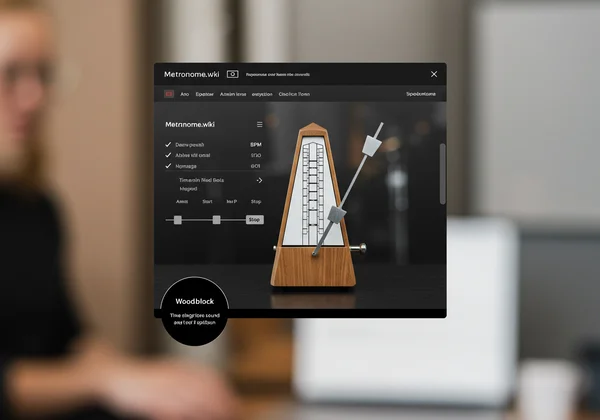Master Rhythm & Timing with Our 30-Day Free Online Metronome Challenge
Feeling frustrated with inconsistent timing or a shaky internal rhythm? Many musicians, from beginners to seasoned players, struggle to effectively integrate a tool into their practice. The steady click-click-click can feel more like a judge than a guide. But what if you had a clear, actionable roadmap to turn that click into your greatest ally? This is where our 30-day Metronome Challenge comes in. This guide is your definitive plan to develop a rock-solid internal clock, improve your precision, and make practice sessions more engaging than ever. Can a metronome improve my rhythm? Absolutely, and we're here to show you how, day by day, using our customizable free online metronome. Get ready to transform your musicality with a structured approach that guarantees results.

The Power of a Metronome Practice Plan: Why Structure Beats Randomness
Randomly turning on a metronome and playing along is a start, but it lacks direction. A dedicated metronome practice plan transforms aimless repetition into purposeful training. Structure provides clear goals, measurable progress, and a systematic way to conquer rhythmic weaknesses. Instead of just "practicing with a metronome," you'll be actively building skills, brick by brick, from fundamental stability to complex polyrhythmic accuracy. This methodical approach is the secret to moving beyond simply keeping time and truly internalizing rhythm.
Building Your Internal Rhythm Clock: More Than Just Keeping a Beat
The ultimate goal of metronome practice isn't to become dependent on an external click; it's to develop an unwavering internal rhythm clock. This is your innate sense of time that keeps you steady even when the music becomes complex or when you're performing without a drummer. Consistent, focused practice trains your brain and muscles to feel the pulse, anticipate the beat, and execute notes with surgical precision. It’s the difference between a performance that feels mechanical and one that grooves with confidence and life. Every exercise in this challenge is designed to strengthen that internal clock.
Getting Started: Essential Mindset & Tools for Your 30-Day Journey
Before you begin this 30-day music challenge, the right mindset and tools are crucial. First, be patient with yourself. Rhythm is a skill built over time. Some days will feel great, others will be a struggle. Consistency is more important than perfection. Second, you need a reliable tool. Your smartphone app might be fine, but a dedicated, distraction-free tool is better. The free online tool on our homepage is perfect for this challenge. It’s accurate, highly customizable, and works on any device. Set it up, choose a clear sound like a woodblock, and you're ready to begin.

Your Daily Rhythm Practice: The 30-Day Breakdown
This is the core of the challenge. We've broken down the next 30 days into two distinct phases. Dedicate at least 10-15 minutes each day to these exercises. The key is consistent, focused effort. Grab your instrument (or just clap along) and let's get started. Remember to start your practice with our easy-to-use metronome.
Weeks 1-2: Mastering Basic Beat-Keeping & Subdivisions
The first two weeks are all about building a solid foundation. Don't rush this! True mastery comes from perfecting the basics. We'll focus on locking in with the pulse and understanding core subdivisions.
- Day 1-4: The Quarter Note Lock-In. Set your metronome to a slow 60 BPM (Beats Per Minute). Play a single note (or clap) precisely on each click. Your goal is to make your sound and the metronome click disappear into a single, unified pulse. Focus intensely. Once comfortable, slowly increase the tempo by 5 BPM increments each day, up to 100 BPM.
- Day 5-9: Introducing Eighth Notes. Go back to 60 BPM. Now, play two even notes for every one click (e.g., "1-and, 2-and, 3-and, 4-and"). The "and" must fall exactly in the middle of each click. This is your first step into basic beat-keeping with subdivisions. Gradually increase the tempo as you feel more stable.
- Day 10-14: The Rhythm Pyramid. Start at 70 BPM. Play one full measure of quarter notes, then one measure of eighth notes, then one measure of sixteenth notes (four notes per click), and then come back down: a measure of eighths, and a measure of quarters. This exercise is fantastic for developing smooth transitions between different rhythmic values.
Weeks 3-4: Advanced Timing & Dynamic Rhythm Exercises
Now that your foundation is strong, it's time to challenge your internal clock. These exercises are designed to test your stability and introduce more musical, advanced timing concepts.
- Day 15-20: The Off-Beat Challenge. Set the metronome to a comfortable tempo (e.g., 80 BPM). Instead of hearing the click as beats 1, 2, 3, 4, reframe it in your mind as beats 2 and 4. This forces you to feel beats 1 and 3 internally. It’s tricky at first but is one of the most effective ways to develop a strong sense of groove and swing.
- Day 21-25: Silent Gaps. This is the ultimate test of your internal clock. Use our free BPM tool and set it to 4/4 time. Practice playing a simple scale or phrase, but program the metronome to be silent for one or two bars. Your goal is to come back in perfectly on time when the click returns. Start with four bars of clicks and one bar of silence, then gradually increase the silent gap.
- Day 26-30: Exploring Time Signatures. Don't live in a 4/4 world! Use the settings on our online metronome to explore other signatures. Spend these days practicing your scales and exercises in 3/4 (like a waltz) or 6/8 (common in folk and rock ballads). This expands your rhythmic vocabulary and flexibility.
Tracking Your Progress & Conquering Plateaus
To get the most out of this challenge, keep a simple practice journal. Each day, write down the exercise you did and the BPM you worked at. Note how it felt. Was it easy? Did you struggle? This simple act of tracking progress will reveal your growth and help you identify areas that need more work. When you hit a plateau—and you will—don't get discouraged. It's a normal part of learning. Simply lower the tempo by 10 BPM and focus on playing with perfect execution before trying to push the speed again.

Beyond the Challenge: Sustaining Your Improved Timing & Rhythm Skills
Congratulations on completing the 30-day challenge! Your sense of time is undoubtedly stronger. But the journey doesn't end here. The goal now is to integrate these skills into your daily musical life and continue to improve timing and rhythmic precision. The habits you've built are the foundation for a lifetime of rhythmic confidence.
Making Metronome Practice a Lifelong Habit
The key to long-term success is to make metronome use a non-negotiable part of your warm-up routine. You don't need to do intense exercises every day. Simply spending the first five minutes of your practice time playing scales or basic chords with the metronome on is enough to maintain and sharpen your internal clock. This turns it from a temporary challenge into a lifelong habit of excellence. Make it as automatic as tuning your instrument.
Exploring Advanced Techniques with Metronome.wiki's Features
Your journey with rhythm can go even deeper. Use the unique features on our website to continue pushing your boundaries. Have you ever wondered about the exact tempo of your favorite song? Use our tap tempo feature to find it instantly by tapping along. You can then practice that song at its original speed, or slow it down to master difficult passages. Experiment with different sound options to keep your practice from getting stale, or use the visualizer to reinforce the beat. Our tool is designed to grow with you.
Your Rhythmic Mastery: The Next Steps
You've got a comprehensive 30-day plan now, one that will fundamentally transform how you approach rhythm. This challenge is more than a set of exercises; it's a proven system for building the confidence and precision that separates good musicians from great ones. You've seen the path from inconsistent timing to a rock-solid internal clock. The only thing left to do is take the first step.
Your journey to rhythmic mastery starts today. Don't wait. Open our free metronome, set the BPM to 60, and begin Day 1 of your challenge. We're excited to see your progress!
Frequently Asked Questions About Metronome Practice
What is a good BPM for practice when I'm just starting with a metronome?
A good BPM for practice when starting is between 60 and 80 BPM. This range is slow enough that you can consciously focus on placing each note perfectly with the click without feeling rushed. The goal is accuracy, not speed. Once you can play an exercise flawlessly at a slow tempo, you've earned the right to speed it up.
Can using a metronome consistently truly improve my rhythm significantly?
Yes, consistent metronome use is arguably the single most effective way to significantly improve your rhythm. It provides instant, objective feedback on your timing, forcing you to confront and correct inconsistencies. Over time, this external reference gets internalized, building a reliable inner pulse that enhances all aspects of your musicianship.
How can I make metronome practice more engaging and less tedious?
To make practice more engaging, turn it into a game. Challenge yourself to see how many times in a row you can play a phrase perfectly in time. Use different metronome sounds to keep things fresh—our tool at Metronome.wiki offers several. Most importantly, always connect the exercise back to real music. After drilling a scale, try playing a simple melody from a song you love at the same tempo.
What exactly does BPM stand for in music, and how do I choose the right one?
BPM stands for "Beats Per Minute," and it's the standard unit for measuring tempo. A BPM of 60 means there is exactly one beat every second. To choose the right one, start slow enough to play a passage perfectly. If you're learning a new piece, use the tempo tool to find its intended speed, but begin your practice at 50-70% of that tempo, gradually increasing it as you gain confidence.